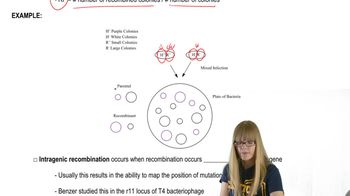A plaque assay studies viruses through what measurement?
Table of contents
- 1. Introduction to Genetics51m
- 2. Mendel's Laws of Inheritance3h 37m
- 3. Extensions to Mendelian Inheritance2h 41m
- 4. Genetic Mapping and Linkage2h 28m
- 5. Genetics of Bacteria and Viruses1h 21m
- 6. Chromosomal Variation1h 48m
- 7. DNA and Chromosome Structure56m
- 8. DNA Replication1h 10m
- 9. Mitosis and Meiosis1h 34m
- 10. Transcription1h 0m
- 11. Translation58m
- 12. Gene Regulation in Prokaryotes1h 19m
- 13. Gene Regulation in Eukaryotes44m
- 14. Genetic Control of Development44m
- 15. Genomes and Genomics1h 50m
- 16. Transposable Elements47m
- 17. Mutation, Repair, and Recombination1h 6m
- 18. Molecular Genetic Tools19m
- 19. Cancer Genetics29m
- 20. Quantitative Genetics1h 26m
- 21. Population Genetics50m
- 22. Evolutionary Genetics29m
5. Genetics of Bacteria and Viruses
Bacteriophage Genetics
Problem 1e
Textbook Question
In this chapter, we have focused on genetic systems present in bacteria and on the viruses that use bacteria as hosts (bacteriophages). In particular, we discussed mechanisms by which bacteria and their phages undergo genetic recombination, which allows geneticists to map bacterial and bacteriophage chromosomes. In the process, we found many opportunities to consider how this information was acquired. From the explanations given in the chapter, what answers would you propose to the following questions? How do we know that intergenic exchange occurs in bacteriophages?
 Verified step by step guidance
Verified step by step guidance1
Understand the concept of intergenic exchange: Intergenic exchange refers to the recombination of genetic material between different genes. In bacteriophages, this process can be studied by analyzing the genetic outcomes of co-infection experiments involving two or more phages with distinct genetic markers.
Review the experimental setup: Scientists often use bacteriophages with known genetic markers (e.g., mutations in specific genes) to infect a bacterial host. By analyzing the progeny phages, they can determine whether recombination has occurred between the genetic markers.
Analyze the evidence of recombination: If intergenic exchange occurs, the progeny phages will exhibit new combinations of genetic markers that were not present in the parental phages. For example, if two parental phages have markers A and B on one phage and a and b on the other, recombination can produce progeny with combinations such as A-b or a-B.
Use statistical analysis to confirm recombination: The frequency of recombinant progeny can be compared to the expected outcomes if no recombination occurred. A higher-than-expected frequency of recombinant types provides strong evidence for intergenic exchange.
Consider the role of mapping: By analyzing the frequency of recombination between different genetic markers, geneticists can construct a genetic map of the bacteriophage genome. This map provides further evidence of intergenic exchange and helps to determine the relative positions of genes on the chromosome.
 Verified video answer for a similar problem:
Verified video answer for a similar problem:This video solution was recommended by our tutors as helpful for the problem above
Video duration:
1mPlay a video:
Was this helpful?
Key Concepts
Here are the essential concepts you must grasp in order to answer the question correctly.
Intergenic Exchange
Intergenic exchange refers to the process by which genetic material is exchanged between different genes, often through mechanisms like recombination. In bacteriophages, this can occur when two different phages infect the same bacterial cell, leading to the mixing of their genetic material. This exchange can result in new phage variants with different traits, which is crucial for understanding phage evolution and adaptability.
Recommended video:
Guided course

Conjugation Overview
Genetic Recombination
Genetic recombination is a fundamental biological process where genetic material is rearranged to produce new combinations of alleles. In the context of bacteriophages, recombination can occur during the lytic cycle when phages replicate within a host. This process is essential for mapping bacterial and phage chromosomes, as it provides insights into gene location and function through the analysis of recombinant phage genomes.
Recommended video:
Guided course

Recombination after Double Strand Breaks
Bacteriophage Genetics
Bacteriophage genetics involves the study of the genetic makeup and behavior of bacteriophages, which are viruses that infect bacteria. Understanding the genetic systems of bacteriophages is vital for exploring their life cycles, interactions with bacterial hosts, and mechanisms of genetic exchange. This knowledge helps researchers utilize phages in biotechnology and medicine, particularly in phage therapy to combat antibiotic-resistant bacteria.
Recommended video:
Guided course

Mapping Bacteriophages

 3:44m
3:44mWatch next
Master Plaques and Experiments with a bite sized video explanation from Kylia
Start learningRelated Videos
Related Practice
Multiple Choice
780
views
1
rank
